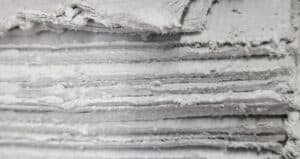What Is Asbestos Made From?
 Asbestos is a naturally occurring mineral that’s found in rocks all over the world. It typically forms in the cracks in soft rock formations and consists of strands of fibrous materials. When asbestos was commonly used, however, it was processed before it could be applied in commercial settings. This means that it was often mixed with other materials so that it became more versatile and usable.
Asbestos is a naturally occurring mineral that’s found in rocks all over the world. It typically forms in the cracks in soft rock formations and consists of strands of fibrous materials. When asbestos was commonly used, however, it was processed before it could be applied in commercial settings. This means that it was often mixed with other materials so that it became more versatile and usable.
How Was Asbestos Made?
 No matter what type of product was being made, the process always began with the mining of asbestos. This allowed companies to access the raw mineral they needed to manufacture asbestos products. Once the ore was brought up from a mine, the asbestos was then separated from the rock and graded, depending on its quality and length.
No matter what type of product was being made, the process always began with the mining of asbestos. This allowed companies to access the raw mineral they needed to manufacture asbestos products. Once the ore was brought up from a mine, the asbestos was then separated from the rock and graded, depending on its quality and length.
These asbestos fibres could then be mixed with other materials and pressed or formed into insulation boards, sheets of asbestos, cement, pipes, and even textiles, as well as various other products.
What Does Asbestos Look Like?
Asbestos consists of bands of fibrous materials, some of which are short and sharp, while others are longer and more flexible. However, the asbestos that has been mined and processed ready for use looks very different to the mineral that is naturally found in rock formations.
A gutter made from asbestos cement might not look any different to a pipe made from cement that doesn’t contain asbestos, for example. Similarly, you may be unable to tell the difference between decorative wall coatings that do and do not contain asbestos.
Although asbestos naturally occurs in different colours (notably white, brown, and blue), people often assume that it’s easy to identify in buildings and structures but, unfortunately, this isn’t the case.
Is Asbestos Still Made Today?
In some countries, asbestos is still mined and manufactured. In the UK, however, the use of asbestos and the importation of the mineral has been banned due to its health risks. Crocidolite, also known as blue asbestos) and amosite (brown asbestos) were both banned in 1985, while chrysotile (more commonly known as white asbestos) wasn’t prohibited until 1999.
Although asbestos is no longer used in the building trade, it remains present in the vast majority of buildings that were constructed prior to 2000. Due to this, it’s important to verify whether a property contains any asbestos before conducting any work on it. If so, it will need to be removed in accordance with strict health and safety regulations.
